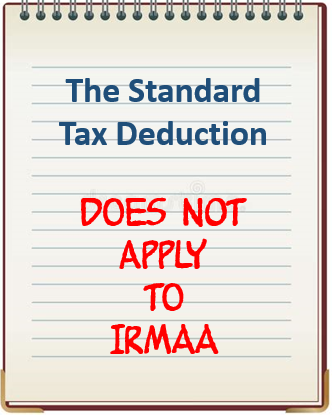When it comes to Medicare’s Income Related Monthly Adjustment Amount (IRMAA) the Standard Tax Deduction does NOT APPLY.
The Social Security Administration (SSA) which is responsible for determining who reaches IRMAA and which surcharge people will pay uses only your adjusted gross income along with any tax-exempt interest you may have in their calculation.
This is your modified gross income (MAGI) which, according to the SSA is defined as:
- “The beneficiary’s adjusted gross income (AGI) (found on line 11 of the Internal Revenue Service (IRS) tax filing form 1040), plus
- tax-exempt interest income (line 2a of IRS Form 1040).
Unfortunately, as you will see when you prepare your taxes, any standard deductions that you may take are not included until line 12 of the IRS form 1040.
This means the Social Security Administration is using your gross income and not your net after the standard tax deduction income to determine if you are hit with another tax through IRMAA or not.
How to determine your IRMAA Income in the first place:
Determining the actual income that the SSA uses to determine can be fairly complex if you want to get into the nitty gritty, but if you want to make it simple just locate your IRS tax-form 1040 from the previous year and look at lines 2a and 11.
For those who want the nitty gritty here are the steps to determine your MAGI:
Step 1:
Locate your IRS tax form 1040 from the previous year.
Step 2:
In the Income section of your IRS form 1040 add lines:
- 1a – Total amount from Forms(s) W-2.
- 1b – Household employee wages not reported on Form(s) W-2.
- 1c – Tip income not reported on line 1a.
- 1d – Medicaid waiver payments not reported on the W-2.
- 1e -Taxable dependent care benefits from Form 2441.
- 1f – Employer-provided adoption benefits from Form 8839, line 29.
- 1g – Wages from Form 8919 (uncollected Social Security and Medicare taxes).
- 1h – Other earned income.
- 1i – Nontaxable combat pay election.
- 2a – Tax-exempt interest.
- 2b – Taxable interest.
- 3b – Ordinary Dividends.
- 4b – Taxable IRA/401(k) /403(b) distributions.
- 5b – Taxable income from Pensions and Annuities.
- 6b – Taxable Social Security benefits.
- 7 – Capital Gains.
- 8 – Other income from Schedule 1.
Step 3:
Subtract any deductions Schedule 1 income from the total amount of Step 2.
This is your Modified Adjusted Gross Income (MAGI) and it will be used to determine if you reach IRMAA.
But what is IRMAA?
IRMAA is a surcharge or tax on your income through Medicare.
The greater a specific type of income you have while enrolled into Medicare the larger your Medicare Part B and Part D premiums will be.
Is IRMAA a big deal?
IRMAA is a tax and historically no tax the federal government creates either goes away or ever gets smaller, and IRMAA will be no different especially if you look at what the federal government is saying.
According to the federal government when it comes to IRMAA:
- The IRMAA surcharges (taxes) will grow by at least 6.00% annually for the next 8 years and will continue at an inflation rate close to 5% after that.
What starts out being only a couple of thousands of dollars will grow to more than a few thousand dollars over the next 8 years and then before you know it will be more than couple tens of thousands of dollars.
- The number of retirees reaching IRMAA will double over the same time frame as the Trustees are expecting that roughly 13.5 million Medicare beneficiaries will reach IRMAA by 2031.
- IRMAA will generate over $354 billion is surcharges over the next 8 years.
IRMAA is not going to get smaller nor will it even go away.

